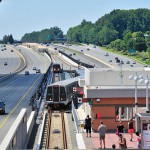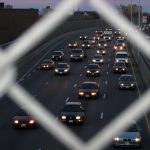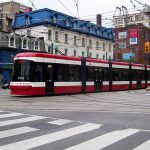Denver’s park-and-rides increase emissions, says study
Park-and-rides — parking lots located near transit depots where drivers drop off their cars and embark on public transit — are meant to limit car-produced pollution, but they may not be all they’re cracked up to be, according to a recent study. The study, “Are park-and-rides saving the environment or just saving parking costs?”, hails from the University of Colorado, Denver, and analyzes single-occupancy vehicles at Denver park-and-rides and the vehicles’ emissions, finding that the closer to downtown a park-and-ride is located, the less sustainable the area becomes.

Providing parking near intermediate stops along Denver’s light rail lines actually increased net CO2 emissions, according to a study. Image by Robert Cutts.
Rising greenhouse gas emissions, or GHG, “have put public transit at the forefront of the push for more sustainable transportation,” according to the study. Park-and-rides are built to improve transit access, letting those who live on the city outskirts leave their cars and commute by transit instead. The reasoning is fair enough: “Vehicle emissions should decrease as drivers shift their mode to public transit. Although the environmental effects from a lone driver may seem marginal, the sum of a larger group that uses park-and-ride facilities multiplies these effects.”
Logic suggests that as people shift from private vehicles to public transit, the transition would reduce vehicle miles traveled, or VMT, and lower the overall carbon footprint. But, in practice, park-and-rides may be contributing to pollution more than they curb it. The study points out a number of problems associated with park-and-rides:
- Lowered traffic, thanks to increased public transit use, can encourage other drivers to drive.
- Park-and-rides can create new trips to access transit.
- Park-and-rides can encourage urban sprawl.
- People still rely on their cars to drive to park-and-ride locations, perhaps driving out of their way.
In this study, researchers analyzed 19 park-and-ride facilities in the Denver metropolitan area, ranging in size from 27 to 1,734 parking spaces. The researchers relied on 2008 data collected by the Denver transit authority: a survey which asked riders about their access to transit, origin and destination points and transit routes, as well as about fare payment and what mode of transportation they would have used if transit was unavailable.
The survey included about 2,000 riders who drove single-occupancy-vehicles to park-and-ride facilities and rode light rail for part of their commutes. Their points of origin and destination were used by researchers in this study to calculate GHG emissions. Using this information, researchers calculated vehicle and transit mileage for each trip; determined mileage for a hypothetical car-only trip; estimated the fuel used and GHG for all the trips; and, lastly, calculated the impact of GHG emissions.
The results? Park-and-rides can encourage drivers to make long trips — as much as 30 miles! — by car to reach a park-and-ride facility. Plus, it “was not unusual” for drivers to skip several, closer park-and-rides in order to park at another locale closer to downtown offering free parking. “The vehicular emissions from these unnecessarily long SOV transit access trips limited the significance of the environmental benefits that could be gained from the use of public transit,” reported the study.
Another downside: Park-and-rides also contributed to extra trips. Up to 46% of drivers drove short distances — less than two miles — in order to access a park-and-ride, rather than biking or walking the short distance to the transit hub. As the researchers explain, “When parking is overabundant, users become less inclined to walk and bike to the stations, and they instead make a short driving trip, which is counterproductive to the overall goal of a sustainable environment.”
There is some good news, however. When drivers begin to incorporate transit into their commute, at a regional level, the community should reap the benefits of a net GHG reduction. The Denver region’s VMT figure for 2008 was 73.4 million VMT each day; the researchers translated this figure to a CO2 emissions equivalent, finding that the area would benefit from a 2% drop in CO2 emissions thanks to park-and-ride users. “Although this figure appears to be a minor reduction, it actually grows larger when all transit users are considered, including those that do not use park-and-rides,” researchers explained.
The most environmentally-friendly locations for park-and-rides, according to the analysis, are end-of-line stations that let commuters ride a longer distance on light rail, as opposed to getting on or off at a more central downtown location. The takeaway? Free parking may seem a boon for drivers, but it is detrimental to the environment: “Provision of free, convenient parking near downtown can be counterproductive. Drivers are provided an incentive to make a longer drive by car and a shorter trip by transit.”
Related Posts
Category: Green Parking, Infrastructure

















